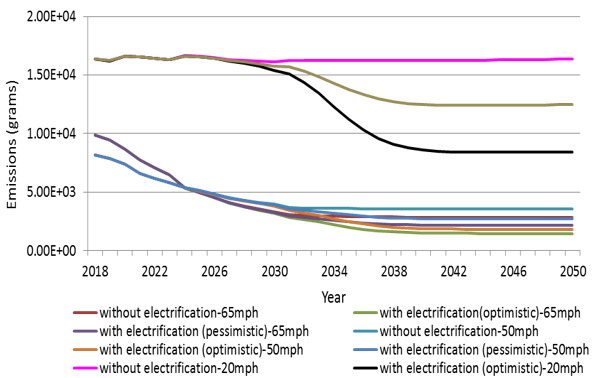Transportation Energy and the Environment
|
|
THE BUSINESS CASE FOR SUSTAINABLE ROAD INFRASTRUCTURE DEVELOPMENT Sponsored by the Indiana Department of Transportation (INDOT). PIs: Samuel Labi, Kumares Sinha, Nadia Gkritza This study will identify sustainable development (SD) opportunities at each phase of infrastructure development; identify/demonstrate exposure metrics for sustainability assessment; document/evaluate trends in SD metrics in Indiana’s transportation; identify carbon credit markets that Indiana could partake; develop SD business-case framework; assess SD impacts on other sectors; and identify ways to integrate SD into INDOT’s culture. Start Date - 09/01/2023 |
 |
MARKET ADOPTION AND IMPACTS OF ELECTRIC ROADWAYS ON CRITERIA POLLUTANTS AND GREENHOUSE GAS EMISSIONS While the emergence of electric vehicles (EVs) has shown capabilities of decreasing energy use and emissions levels, the EV market is developing slowly mainly due to drivers’ range anxiety and charging time. Electric roadways (ERs) have been proposed as a solution to overcome the concerns related to EVs. The objective of this study was to estimate the level of adoption of the ER wireless technology and corresponding market segments and quantify the impact of ERs on criteria pollutants and greenhouse gas (GHG) emissions. A survey of the general population in Los Angeles (LA), CA was conducted, gathering 600 responses. Three clusters emerged from the market segmentation analysis: Early Adopters, Mid-Adopters and Late Adopters being different in terms of demographics and socioeconomic characteristics, travel and EV charging characteristics and level of awareness. The results from the emissions impact assessment suggested that the ER technology has the potential to provide emissions savings for the period of 2018-2050, considering I-710 corridor in LA. Completed 2018 |
 |
Completed 2016 |
|
|
Most U.S. energy usage is for electricity production and vehicle transportation, two interdependent, critical national infrastructures. The strength and number of these interdependencies will increase rapidly as hybrid electric transportation systems, including plug-in hybrid electric vehicles and hybrid electric trains, become more widely used. The 21st Century National Energy and Transportation Infrastructures Balancing Sustainability, Costs, and Resiliency (NETSCORE-21) research project (Award #0835989) was motivated by a recognition that tools, knowledge, and perspective were lacking to design a national system integrating energy and transportation infrastructures while accounting for interdependencies between them, new energy supply technologies, sustainability, and resiliency. Hence, the goal of this research was to formulate optimal infrastructure designs in terms of future power generation technologies, energy transport and storage, and hybrid-electric transportation systems, with balance in sustainability, costs, and resiliency. This project was funded by the National Science Foundation (NSF) via the solicitation on Emerging Frontiers on Research and Innovations (EFRI)Resilient and Sustainable Infrastructures (RESIN) program and was mainly conducted at Iowa State University. Completed 2015 |
